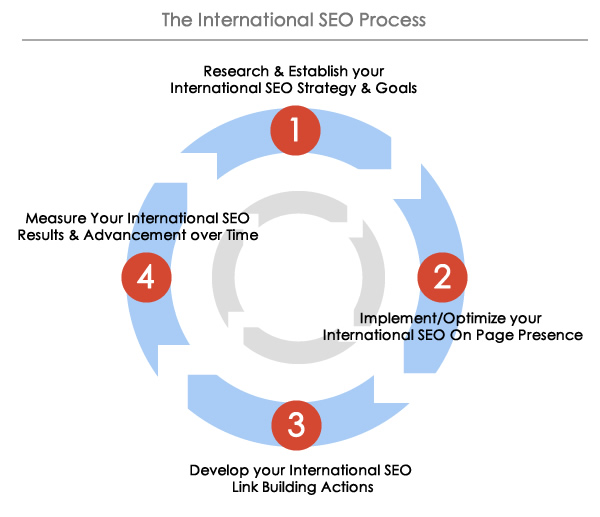Breaking Boundaries: International SEO Techniques for International Domination
Breaking Boundaries: International SEO Techniques for International Domination
Blog Article
Browsing the Digital Landscape: Leveraging International SEO for Cross-Border Success
In today's interconnected electronic world, businesses are significantly looking past boundaries to tap right into global markets. The complexity of navigating the electronic landscape on a worldwide range requires a nuanced approach, from understanding the basics of International Search engine optimization to carrying out geotargeting and multilingual key words methods.
Comprehending International SEO Basics
Browsing the intricacies of global SEO calls for a solid understanding of basic concepts to properly increase on the internet visibility across boundaries. One critical element of worldwide SEO is comprehending the value of localization. This entails customizing web site material to fit the linguistic, social, and commercial differences of target audience. Keyword phrases need to be not only converted but also adjusted to show just how individuals in different regions search for details.
In addition, having a clear understanding of geo-targeting is vital. This includes showing to online search engine the specific countries or areas a site is targeting. Applying hreflang tags is one way to communicate this details, making sure that the right variation of a webpage shows up in the search results page for a customer in a certain place.
In addition, understanding the impact of neighborhood search engines and social media systems is crucial for worldwide search engine optimization success. While Google is dominant in numerous areas, nations like China have their very own search engines like Baidu, calling for tailored approaches for each system to maximize on the internet visibility (International SEO).

Targeting Multilingual Key Phrase Methods
Establishing multilingual search phrase methods is vital for properly getting to varied global audiences and making best use of online visibility across different etymological regions. When targeting multilingual key words methods, it is crucial to perform complete research study to understand the details search terms and phrases used by the target market in each linguistic area. This involves not only converting keywords but additionally thinking about social subtleties, local languages, and search fads unique to each target market.
To create a successful multilingual key words strategy, it is very important to prioritize significance and search intent. Key phrases need to line up with the material on the website and reverberate with the social context of the target audience. Using devices such as Google Keyword Phrase Planner, SEMrush, or Ahrefs can help recognize high-performing keywords in different languages and assess their search quantity and competition degree.
In addition, surveillance and examining the performance of multilingual key words routinely is important for maximizing and fine-tuning the approach in time. By constantly adapting to modifications in search habits and patterns, services can boost their on the internet presence and draw in even more worldwide traffic to their websites.
Implementing Geotargeting and Hreflang Tags
When intending to boost global search engine optimization strategies, try here integrating geotargeting and hreflang tags is important for maximizing internet site exposure across various regions. Geotargeting entails tailoring content to particular areas, making sure that users in various locations receive pertinent info. By applying geotargeting, businesses can improve their local search positions and draw in region-specific website traffic.

Optimizing Website Structure for Global Presence
To better boost global search engine optimization methods past geotargeting and hreflang tags, maximizing the site framework is critical for attaining international presence and maximizing reach throughout various regions. A well-structured website not only enhances customer experience however additionally helps with online search engine spiders in comprehending the material and context of the website. When going for global visibility, it is essential to make sure that the web site is arranged in a rational fashion that deals with users from numerous countries. Implementing a clear hierarchy with unique groups and subcategories can assist in enhancing the website's navigation view it and user-friendliness.
Additionally, creating language-specific subdirectories or subdomains can help internet search engine deliver the best variation of the website to customers based upon their language preferences, further improving the general individual experience. Furthermore, maximizing URL frameworks to include pertinent search phrases and geotargeted terms can enhance the site's visibility in various regions. By structuring the internet site properly for worldwide audiences, services can raise their chances of bring in international website traffic and broadening their reach across boundaries.

Monitoring and Evaluating Cross-Border Performance
Efficient monitoring and studying of cross-border efficiency is essential for evaluating the success of worldwide search engine optimization approaches and identifying possibilities for renovation in international reach and exposure. By carefully tracking key performance indications (KPIs) across various markets, services can acquire beneficial understandings right into the efficiency of their cross-border SEO efforts. Keeping track of metrics such as natural traffic, keyword positions, conversion prices, and bounce rates can give an extensive sight of how well a site is performing in various areas.
Evaluating cross-border performance data permits companies to determine patterns, patterns, and areas for optimization. By comparing performance across different countries, areas, or languages, companies can identify successful strategies and center content to much better deal with specific target audiences. Furthermore, monitoring cross-border performance makes it possible for services to stay active and receptive in the ever-evolving digital landscape. Regular analysis of SEO performance on an international range makes sure that business can adapt their methods swiftly to maximize emerging possibilities and maintain a competitive edge in global markets.
Conclusion
To conclude, worldwide SEO plays an important function in attaining cross-border success by optimizing internet sites for global presence, targeting multilingual keyword phrase approaches, implementing geotargeting and hreflang tags, and keeping track of cross-border performance. By comprehending the fundamentals of global SEO and enhancing web site structures appropriately, organizations useful site can effectively reach and engage with their target market across various areas and languages. This tactical approach is important for expanding market reach and driving on-line development in today's electronic landscape.
Report this page